Heraclius
Heraclius: emperor of the East-Roman (Byzantine) empire (r.610-641).
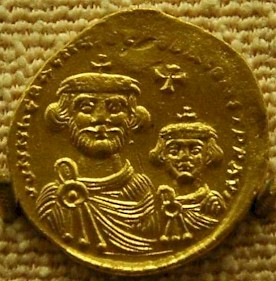
The inhabitants of Constantinople must have sighed with relief when, in October 610 CE, they saw a fleet approaching. A blonde hero stood on the main ship’s forecastle, to which he had attached an icon of the Mother of God. For more than seven years, the citizens of the capital of the Byzantine Empire had been forced to endure one of the most cruel and incompetent rulers who had ever worn the imperial purple: Phocas, a former officer who had been raised to the throne by the army and had almost brought the empire to ruin. And now, rescue was near.
Coup
The newcomer was Heraclius and although his last port of call had been Thessaloniki, his fleet arrived from Africa, where his father was exarch (governor) of Carthage and the driving force behind the revolt. It took his son little effort to enter the city, because hardly any measures had been taken to defend the walls. Besides, the urban elite was only too happy to collaborate. Two guardsman handed over the mutilated body of Phocas to Heraclius. The former emperor’s limbs were cut off, the corpse was beheaded, and the head was carried through the city on a spear.
On the same day, the patriarch of Constantinople crowned Heraclius emperor and married him to Fabia, the daughter of an African landowner, who would from now on be called Eudocia. The new emperor was thirty-five years old. One year later, the couple’s first daughter was born, Epiphania, who suffered from epilepsy and died early. Shortly after, a son was born, Constantine.
The Persian crisis
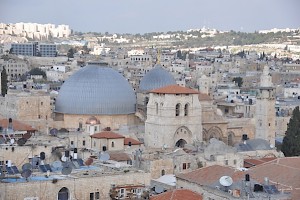
Heraclius inherited a war against the Sasanian Persians, who had threatened the borders for almost four centuries. Their main commander, Shahrbaraz, took control of Antioch in 612 and Damascus in 613, proceeding to Jerusalem in the next year. In the last city, thousands of monks, priests, and nuns were murdered in three days, while the patriarch Zacharias was imprisoned. No house was spared and the Basilica of the Holy Sepulchre was laid in ashes, as were the graves of Christians. Even worse, the True Cross was seized, together with the lance and sponge used during the crucifixion of Jesus – a disgrace to the Byzantines that had to be avenged anyway.
To make matters even worse, the Persians also seized Alexandria in Egypt and blocked the corn supply to Constantinople. Famine erupted, followed by an epidemic. Heraclius was desperate and even thought about moving the capital to North Africa. A ship, filled with valuables, was already on its way, but it suffered shipwreck in a violent storm.
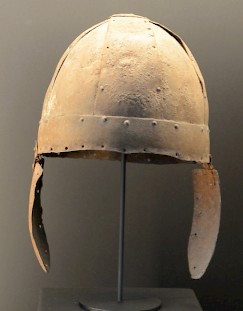
At this moment, the patriarch of Constantinople, Sergius, intervened. He made the emperor swear that he would never give up the city and offered to melt the church treasures, allowing Heraclius to use the gold and silver as a loan to bring his army back to strength. The emperor took courage and decided to cross into Asia at the head of a new army. It was to be a holy war, meant to get back the True Cross. But first, after the death of Eudocia, he married his cousin Martina: an act of incest that gave him a bad name among the clergy and the populace. She would become the most hated woman of the Byzantine Empire.
The preparations of the war took several years. Years that witnessed a monetary reform, backed up by Sergius’ gold and silver, and an army reform. The troops were reorganized in small, self-sufficient units, which were more useful during the long, faraway campaign Heraclius was contemplating.
War against Persia
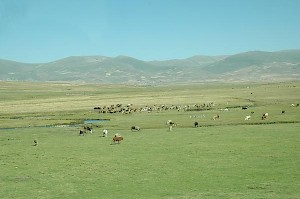
Martina accompanied her husband during the Persian campaign, which started in April 622 and went wonderfully successful. Having made a landing in Cilicia, far behind enemy lines, he defeated the Persian general Shahrbaraz. Having spent the winter in Trapezus on the shores of the Black Sea, Heraclius invaded Armenia and proceeded to Ctesiphon in Babylonia. In the next year, he invaded Albania (a kingdom in the Caucasus), and he spent the winter near Lake Van. In 625, he proceeded to Amida on the Upper Tigris, to Samosata on the Upper Euphrates, to Adana in Cilicia. He won a new victory over Shahrbaraz, and spent the winter in Trebizond again. Byzantine control of Anatolia was restored.
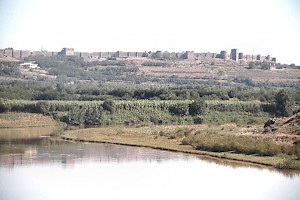
His success is partly explained by the military reforms. The self-sufficient units were more mobile than anyone had expected. Another explanation is that in 625, he signed a treaty with the Khazars in the Caucasus. They were a remainder of the Hunnish federation and were also called Tourkoi by the Byzantine writers. Having received precious gifts from Heraclius and a promise that their leader would marry Heraclius’ daughter, they promised to join the fight against the Persians. Heraclius had the advantage of large numbers.
Still, Heraclius’ expedition was under threat because another nomadic group from Central Asia, the Avars, together with Slavs, and Bulgarians arrived from the north to lay siege to Constantinople. At the same time, Shahbaraz’ Persian forces reached Chalcedon, on the Asian bank of the Bosphorus, ready to join the Avar attack on the Byzantine capital. Like Heraclius’ army, the Persians were capable of proceeding behind enemy lines.
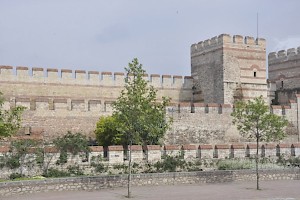
However, Heraclius was not distracted. He knew that the walls of Constantinople were impenetrable. Moreover, the patriarch carried the miraculous icon of the Mother of God, painted by the evangelist Luke, along the walls, which inspired the defenders. When the Avars launched their attach, they were defeated and drowned “like the Egyptians in the Red Sea”, as the Byzantines noted. In 626 the Avar army retreated, announcing that they would be back soon.
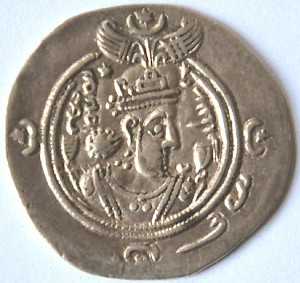
The king of Persia was Khusrau II “the Victorious”. When he learned of the Avar retreat, he sent a messenger to Shahrbaraz, ordering him to return with his army as soon as possible. However, the Byzantines intercepted the message and forwarded another letter, which had been dictated by Heraclius. It said that the general had to stay where he was. The ruse was successful and for months, the Byzantine field army did not encounter serious resistance. In December 627, Heraclius defeated a large Persian army near the ruins of ancient Nineveh. The battle lasted eleven hours but was decisive. The head of the Persian commander was put on a stake and exposed in the Byzantine camp, while no less than twenty-eight Persian banners were captured. After many years, the archenemy was finally defeated.
Revolution in Persia
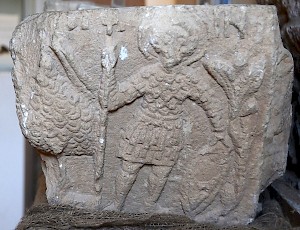
The military reverse was the direct cause of a palace coup in Persia. Early in 628, crown prince Sheroe had his father put in jail, where he would die not much later. Sheroe now succeeded to the throne and accepted the name of Kavad II. He immediately sent envoys to Heraclius, whom he called “my brother”. The new Persian king expressed his wish to live in peace and harmony with the Byzantines and promised to release all POWs. The emperor appreciated the overture and demanded that the True Cross were returned. However, the negotiations broke off because the young Persian king died, but his successor, general Shahrbaraz, who briefly ruled in 629, finally accepted a treaty.
Heraclius was at the zenith of his fame. On September 14, 628, he triumphantly returned to Constantinople, entering the city through the Golden Gate, displaying the True Cross in a chariot that was pulled by four elephants. In 630 he returned the relic to Jerusalem and there, in the presence of patriarch Zacharias, began the restoration of the church of the Holy Sepulchre. He was to stay in Asia for seven years: there were many things to put in order.
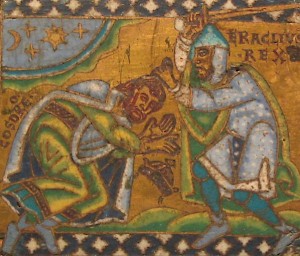
He divided the Asian part of the Byzantine Empire into four themata, a word that means “army placements”. Each theme was placed under the authority of a strategos or military governor, and many peasants received plots of land on the condition that they and their male descendants would serve as soldiers. This reorganization (which cannot be dated precisely) was to be of great importance: from now on, the emperors had a reliable army and were no longer dependent on mercenaries or barbarians, who were never as loyal as farmers defending their own land. A whole new class of farmer-soldiers came into being, which would serve and strengthen the Byzantine state for centuries to come.
At the same time, Heraclius was running short of cash. The Persian War had taken its toll, and the emperor, despite obtaining large amounts of Persian gold and silver, was forced to dismiss soldiers and reduce their armaments. He still had to pay his debts to the church, which had once melted its silver and gold to pay for the defense of Constantinople.
Ecclesiastical matters
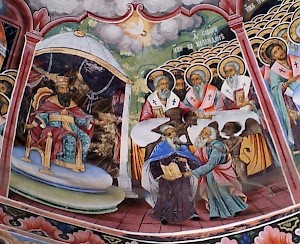
There was another problem, of a very different kind. For a long time, Christian theologians had been debating the relationship between the divine and human natures of Christ. Too much emphasis on his divine nature would distract from his humanity, but on the other hand, Christ’s divine nature looked imperiled if Christ was seen too much as a human being. Several councils had been devoted to this question, and in the end the Council of Chalcedon (451) had agreed upon a definition: Christ was “perfect both in deity and in humanness” and the two natures were inseparably united. People who did not keep to this doctrine were considered heretical.
Unfortunately, this solution did not satisfy everyone. Especially in Egypt, Syria, and Armenia, the majority of believers remained convinced that the divine nature of Christ had overwhelmed or absorbed his human one, so that only one nature remained, the divine. The adherents of this idea were called “Monophysites”. The provinces were of great economic importance to the Byzantine state and because the Chalcedonian Definition had be recognized by the emperor Marcian, none of his successors could allow these provinces to go their own way – that would amount to accepting a humiliating loss of imperial dignity. However, punitive actions against the supporters of Monophysitism were dangerous because of the strategic and economic importance of the provinces.
That is why Heraclius personally dealt with this issue. Together with Sergius, the patriarch of Constantinople, and Cyrus, the archbishop of Chalcedon, he proposed a compromise. In Christ, they argued, there was not one nature, but one energy (Monoergetism) or active force. With this proposal, the emperor hoped to reunite all Christians. However, Sophronius of Jerusalem (the future patriarch of that city), vigorously opposed this formula and forced Heraclius to retreat.
In 638, the emperor issued an ekthesis (decree) that was hung in the narthex of the church of Divine Wisdom in Constantinople, in which Heraclius declared that from now on, it was forbidden to speak of one or two energies, but that Christ had had one will (thelema). This Monotheletism was almost universally rejected: although the Maronite Christians were Monothelitists for quite some time, the new compromise was unacceptable for both the adherents of the Chalcedonian Definition and the Monophysites, while pope John IV explicitly condemned Monotheletism.
Heraclius was disappointed and gave up all further attempts to solve the problem. On his deathbed, he would mumble that he had agreed only reluctantly to a proposal by Sergius. It had been the patriarch’s initiative and it was not his fault, the emperor claimed, obviously not speaking the truth. The issue has remained unresolved: the Coptic and Armenian churches still reject the Chalcedonian Definition.
The Arab war
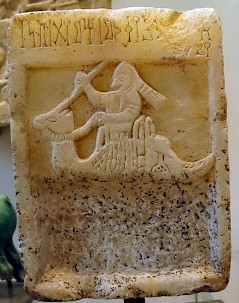
In the meantime, a new crisis had started in the east, which would bring about the greatest difficulties for the Byzantine Empire: the Arabs had found a Monotheistic faith, Islam, had overcome their divisions, and were encroaching upon the eastern provinces of Heraclius’ realm. Soon after the death of Muhammad (632) the Arab expansion had begun and the Arabs threatened not just the Byzantine Empire, but Sassanian Persia as well. Worse, both superpowers were still exhausted from their titanic struggle.
The Arabs rapidly advanced and took Damascus in 635. Everywhere, they received support from the local population: the Syrians, who were Monophysites, knew that the conquerors would not impose the heavy taxes that Heraclius needed for the reconstruction of his eastern provinces.
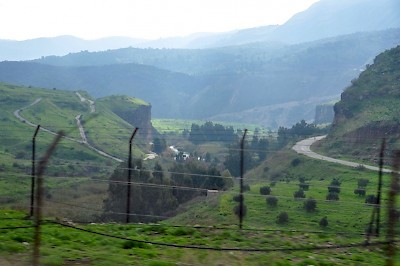
Although the Byzantine Empire was exhausted from the Persian war, the emperor managed to build an army for a counterattack. In 636, he gathered 80,000 men near Antioch. The Arabs retreated from Damascus and Emesa, and camped near the river Yarmouk, a tributary of the Jordan. In May, the imperial army advanced to the south, but for reasons that have remained unclear to us, the final attack was postponed for three months. This had fatal consequences.
The blazing heat undermined the morale of the Byzantine troops and to make matters worse, a violent sandstorm struck from the south, blinding Heraclius’ soldiers. Of course this was the moment the Arab commander, Khalid, had been waiting for. He attacked and defeated Heraclius' army. His victory was decisive: the Byzantines were unable to rebuild an army and the Monophysites accepted the Arabs as liberators.
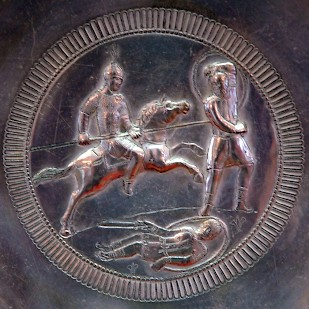
And so, the Arab armies reoccupied Damascus and Emesa. In the autumn of 637, patriarch Sophronius of Jerusalem surrendered his city to caliph Omar, the second successor of Muhammad. Not much later, the Arabs conquered Egypt (641). The next year, they defeated the Sassanians in the battle of Nahavand, which was the beginning of the end for Persia.
It was disaster and Heraclius collapsed. He had not personally participated in the fight because he suffered from dropsy. His health, already poor, declined and he had mental problems. He was convinced God had abandoned him and had sided with the Arabs, whose new faith looked like some kind of new Christianity, apparently superior to the theological compromises he had attempted.
He left Syria, returning to his capital, tired and exhausted. Reaching the Bosphorus, he suddenly had an inexplicable aversion to the sea. He even hid in a side room of one of the imperial palaces on the Asian shore, unable to proceed to Constantinople, ignoring the urgent pleas of the city’s representatives. He became paranoid, believed rumors about a conspiracy by his nephew and a bastard son, and ordered their noses and hands to be cut off before sending them into exile.
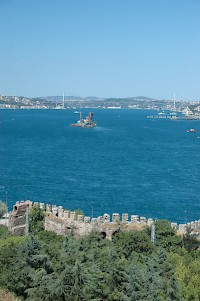
After a few weeks, his wife Martina and members of the court found a solution. Patriarch Nicephorus, who wrote a Breviarium or Short History, reports that a large number of boats was tied together, as if it were a bridge, to which they added a “wall” of tree branches and leaves, so that the emperor would not have to look at the sea. It worked: the emperor passed the sea on horseback as if he were traveling on land.note
Death
After Heraclius arrived in the city, his physical condition deteriorated. The emperor’s dropsy was incurable and on February 11, 641, he died. He was buried in the Church of the Holy Apostles, and for three days his sarcophagus remained open, eunuchs seated around it. The emperor had ordered this odd procedure, because he had been afraid of being buried alive.
His subjects were sure that their ruler had been punished by God because of the incestuous marriage to Martina, his cousin. She had given him eleven children, four of whom had died young and two who had been disabled – another sign of the Lord’s displeasure. After his death, she was publicly condemned. She had arranged for her eldest son to become co-emperor, along with Constantine, Heraclius’ son from his first marriage, with Eudocia.
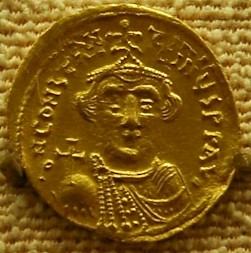
However, Constantine III and Heraclonas, as the two joint emperors were called, were not to rule for a long time. Constantine suffered from tuberculosis and died in May. In the summer, Martina and Heraclonas were arrested. Her tongue was torn out, her nose cut off, and she was exiled to Rhodes, together with her son. The new emperor, who was unable to recover Syria and had to witness the loss of Africa, was a son of Constantine III named Heraclius, who officially reigned as Constantine but is usually called Constans II Pogonatus ("the bearded one").